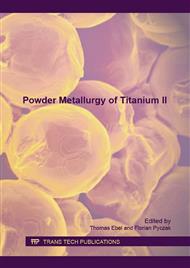[1]
G. Lütjering, J.C. Williams, Titanium, second ed., Springer, Berlin, Heidelberg, New York, (2007).
Google Scholar
[2]
T. Imwinkelried, Mechanical properties of open-pore titanium foam, J. Biomed. Mater. Res. Part A 81 (2007) 964-970.
DOI: 10.1002/jbm.a.31118
Google Scholar
[3]
G. Ryan, A. Pandit, D.P. Apatsidis, Fabrication methods of porous metals for use in orthopedic applications, Biomaterials 27 (2006) 2651–2670.
DOI: 10.1016/j.biomaterials.2005.12.002
Google Scholar
[4]
A. Laptev, M. Bram, H.P. Buchkremer, D. Stöver, Study of production route for titanium parts combining very high porosity and complex shape, Powder Metall. 47 (2004) 85-92.
DOI: 10.1179/003258904225015536
Google Scholar
[5]
A. Laptev, O. Vyal, M. Bram, H.P. Buchkremer, D. Stöver, Green strength of powder compacts provided production of highly porous titanium parts, Powder Metall. 48 (2005) 358-364.
DOI: 10.1179/174329005x73838
Google Scholar
[6]
M. Bram, A. Laptev, H.P. Buchkremer, D. Stöver, Herstellung von hochporösen, endkonturnahen Titan-Formkörpern für biomedizinische Anwendungen, Materialwiss. Werkst. 35 (2004) 213-218.
DOI: 10.1002/mawe.200400731
Google Scholar
[7]
A. Laptev, M. Bram, Manufacturing hollow titanium parts by powder metallurgy route and space holder technique, Mater. Lett. 160 (2015) 101-103.
DOI: 10.1016/j.matlet.2015.07.094
Google Scholar
[8]
H. Schiefer, M. Bram, H.P. Buchkremer, D. Stöver, Mechanical examination on demntal implants with porous coating, J. Mater. Sci.: Mater. Med. 20 (2009), 1763-1770.
DOI: 10.1007/s10856-009-3733-1
Google Scholar
[9]
M. Bram, C. Kempmann, A. Laptev, D. Stöver, K. Weinert, Investigation on the machining of sintered titanium foams using face milling and peripheral grinding, Adv. Eng. Mater. 5 (2003) 441-447.
DOI: 10.1002/adem.200300356
Google Scholar
[10]
ASM Handbook v. 7. Powder metal technologies and applications. ASM International, (1998).
Google Scholar
[11]
M. Bram, A. Laptev, D. Stöver and H.P. Buchkremer, BRD Patent 10224671. (2003).
Google Scholar
[12]
N. Tuncer, M. Bram, A. Laptev, T. Beck, A. Moser, H.P. Buchkremer, Study of metal injection molding of highly porous titanium by physical modeling and direct experiments, J. Mater. Process. Technol. 214 (2014) 1352-1360.
DOI: 10.1016/j.jmatprotec.2014.02.016
Google Scholar
[13]
A.P. Cysne Barbosa, M. Bram, D. Stöver, H.P. Buchkremer, Realization of a titanium spinal implant with a gradient in porosity by 2-component metal injection moulding, Adv. Eng. Mater. 15 (2013) 510-521.
DOI: 10.1002/adem.201200289
Google Scholar
[14]
N.F. Daudt, M. Bram, A.P. Cysne Barbosa, C. Alves Jr., Surface modification of porous titanium by plasma treatment, Mater. Lett. 141 (2015) 194-197.
DOI: 10.1016/j.matlet.2014.11.083
Google Scholar
[15]
A.M. Laptev, N.F. Daudt, O. Guillon, M. Bram, Increase of shape stability and porosity of injection molded highly porous titanium parts, Adv. Eng. Mater. 17 (2015) 1579-1587.
DOI: 10.1002/adem.201500061
Google Scholar
[16]
J.P. Li, S.H. Li, K. de Groot, P. Layrolle, Preparation and characterization of porous titanium, Key Eng. Mater. 218-220 (2002) 51-54.
DOI: 10.4028/www.scientific.net/kem.218-220.51
Google Scholar
[17]
P. Quadbeck, K. Kümmel, R. Hauser, G. Standke, J. Adler, G. Stephani, B. Kieback, Structural and material design of open-cell powder metallurgical foams, Adv. Eng. Mater. 13 (2011) 1024-1030.
DOI: 10.1002/adem.201100023
Google Scholar
[18]
P. Heinl, A. Rottmair, C. Körner, R.F. Singer, Cellular titanium by selective electron beam melting, Adv. Eng. Mater. 9 (2007) 360-364.
DOI: 10.1002/adem.200700025
Google Scholar
[19]
Information on http: /www. arcam. com.
Google Scholar
[20]
ASTM F67-13, Standard specification for unalloyed titanium, for surgical implant applications (UNS R50250, UNS R50400, UNS R50550, UNS R50700), ASTM International, West Conshohocken, PA, (2013).
DOI: 10.1520/f0067
Google Scholar
[21]
Implants for surgery, metallic materials. Part 2: Unalloyed titanium, ISO 5832-2: 1999, ISO, Geneva, Switzerland.
Google Scholar
[22]
ASTM F2989-13, Standard specification for metal injection molded unalloyed titanium components for surgical implant applications, ASTM International, West Conshohocken, PA, (2013).
DOI: 10.1520/f2989-21
Google Scholar
[23]
A.T. Sidambe, Biocompatibility of advanced manufactured titanium implants. A review, Materials 7 (2014) 8168-8188.
DOI: 10.3390/ma7128168
Google Scholar


